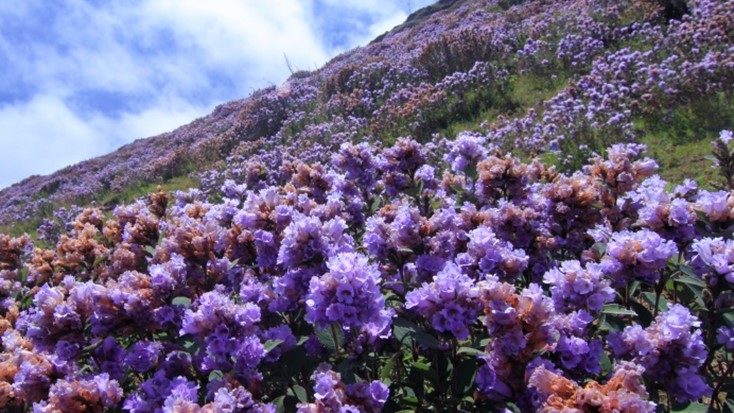‘Beside the lake, beneath the trees,
Fluttering and dancing in the breeze.
Continuous as the stars that shine
And twinkle on the Milky Way,
They stretched in never-ending line
Along the margin of a bay:
Ten thousand saw I at a glance,
Tossing their heads in sprightly dance’
An excerpt from the poem ‘I wandered lonely as a cloud’ by William Wordsworth
Although the poet was originally inspired by daffodils to write this well-known poem, the words also fit perfectly for the mass flowering of plants of the genus Strobilanthes or Karvi. The genus has around 350 species, out of which, at least 46 are found in India. After a span of a few years, the plants flower together in a brilliant synchrony, painting the hillsides with blues and purples wherever they are growing. To experience this nature’s splendour, one does not need to travel far. Our city, Mumbai, offers the view of these blooming beauties throughout the forests of Sanjay Gandhi National Park. Strobilanthes callosa, the species of Karvi found in the forests of Mumbai is a large shrub which blooms after every 8 years in the months of July to September. With the arrival of monsoon, the plant comes alive with bright green leaves and is reduced to dry stems once monsoon period ends. To catch these plants in a mass bloom, one has to watch out the year they bloomed last. Last bloom occurred in 2016 and therefore, the next one would be in 2024. Similarly, another species called Strobilanthes kunthiana or Neelakurinji decorates the hills and valleys of Nilgiris in South India after every 12 years. The name of these hills literally means ‘Blue Hills’ due to the carpet of flowers which covers them every mass-bloom.
What makes these plants so special?
Plants which flower, leave their seeds behind and die are called Monocarpic plants. They can be annual (complete their entire life cycle in only one growing season), biennial (complete their life cycle in two growing seasons) or perennial (life cycle consists of several years). Plants such as Bamboo and Agave can flower after a hundred years and then perish, although synchronised mass flowering of individuals is not observed in them.
Individuals of Strobilanthes genus are called Plietesials. Bremekamp (1944:20) used the term plietesial in reference to perennial monocarpic plants “of the kind most often met within the Strobilanthinae” (a subtribe of family Acanthaceae containing Strobilanthes and allied genera) that usually grow gregariously, flower simultaneously following an interval of several years, set seed, and die. The flowering periodicity in all individuals of the species is rarely 100% as some individuals can be found flowering in non-mass flowering years. Mass-flowering can occur over a wide area in a species-specific cycle or some populations in different regions might follow their own cycles. Such a lifecycle has been observed in not only Strobilanthes but also several other plant species from genera Stenosiphonium and Isoglossa.
Why do plants show such a lifecycle?
Plants undergo flowering once they reach maturity. In different plant species, this time period can vary from a few days, months or years. Perennial monocarpic plants can require several years to reach maturity after which they flower. In case of Plietesials, the first generation of plants set seed together which germinate at the same time. This leads to synchronised flowering. Death after seed formation in these plants is triggered by an endogenous control system involved in senescence and not external factors. Deterioration of plant parts with age is called Senescence. These processes might be triggered by flowering or by seed formation. Whole plant senescence is generally accompanied by decline or a halt in net photosynthesis as well as root and shoot growth. There are some theories which have been proposed to explain this dramatic event (these theories might not hold true for all plants). Let us take a look at them:
1. Nutrient Deficiency Theory:
Molisch (1938) was probably the first to study Monocarpic senescence and he concluded that the reproductive floral organs draw nutrients towards them to such an extent that barely anything is left for the vegetative plant parts. This causes the plant to perish after seed formation takes place. This means that the reproductive organs act like a very strong ‘sink’ which mobilizes the plant’s nutritional supply. This was recently demonstrated in the Gladioli where leaves of the plant were supplied with labelled CO2. When these assimilates were tracked during plant development, it was observed that all of it was diverted towards flower development.
2. Hormonal Theory:
Root tips are sites of cytokinin synthesis. Cytokinin is a plant hormone which has shown to possess senescence retarding effects. It moves upwards from the roots and affects the growth of aerial organs. Since whole plant senescence involves termination of root growth, no new roots would be formed and no cytokinin would be produced which can stop the process of senescence.
3. Predator Satiation Theory:
The mass flowering and subsequent fruit formation floods the area with fruits and seeds. Fruiting at the same time ensures that even if predators were to feed on a large proportion of seeds, some would still be left to germinate and grow into new plants. The theory might not hold true for some plants such as bamboo where the time interval of flowering is ten times more than the lifespan of local rodents which feed on the seeds.
Some notable plants which exhibit this phenomenon:

Strobilanthes Callosa
The shrub takes 7 years to mature after which it bears flowers in the next year. Fruits formed after mass flowering dry by the subsequent year. With the first shower of monsoon, the fruits burst with a pop and disperse the seeds. The flowers are rich in nectar and attract several species of birds, butterflies and bees. Local wild bee hunters collect honey after the mass flowering which is a local delicacy.
Strobilanthes kunthiana
The plant takes 12 years to mature and bloom. They once used to cover the Anamalai Hills, Cardamom Hills, Nilgiri Hills and several other locations but much of their habitat has now been replaced with tea plantations and residential areas. Kurinjimala Sanctuary protects the Kurinji in approximately 32 Km2 core habitat in Kottakamboor and Vattavada villages in Idukki district of Kerala.

Stenosiphonium – Three species of the genus, S.cordifolium, S.setosum and S.wightii have been suggested to be Plietesials. The former is widespread in Peninsular India and Sri Lanka whereas the latter two are endemics of Western Ghats and considered as rare by IUCN.

Bamboo
Bamboos can require 40-80 years to reach maturity after which they undergo mass flowering. The longest recorded flowering interval is known in Phyllostachys bambusoides (Japanese Timber bamboo) which is 130 years. Since bamboos can propagate vegetatively from shoots at the roots, all plants that are derived from the same stock plant will flower at the same time and die regardless of location or climate.
Agave americana
Also called as the Century plant, the plant takes 10 – 30 years to mature after which, it bears a gigantic inflorescence. The floral stalks can reach a height of 25-30 ft and bears bright yellow flowers. Once the flowering is complete, the plant dies. It is native to Mexico and United States but now has been naturalized in many places such as the Mediterranean, South America, India, China, etc.


Corypha umbraculifera
The Talipot Palm is native to eastern and southern India and Sri Lanka. It produces the largest branched inflorescence in the world. It requires 60 years to reach maturity after which it flowers and dies shortly after seed production.
Effects on ecosystems:
Mass flowering of plants leads to a boom in the population of the organisms which feed on the nectar, fruit and seeds. It has been observed that mass flowering leads to increased reproductive efficiency and seed setting. Populations of insects increase which leads to an increase in pollination of the flowers. These insects are predated upon by birds and reptiles which keeps the cycle of nature going. Some plants have large time intervals between flowerings which might be beneficial to control the predator animal population.
Social impacts:
Mass flowering of Bamboo species Melocanna bambusoides can cause disastrous effects on the villages around Bay of Bengal. The plants flower once every 30 – 35 years, set seed and die on a large scale. This deprives local people from building material and as rodent population increases exponentially during the seed setting, these rodents feed on the seeds and then turn their attention towards stored grain and agricultural crops. This has led to famines in the past as well as spread of disease.
Threats:
The Nilgiris are suffering by the spread of invasive alien species such as Cestrum aurantiacum and Lantana camara which out-compete the native plants for resources and space. Tree species such as Prosopis juliflora and Eucalyptus were planted decades ago to aid the rural population with timber and commercial products such as tannins. These trees are also invasive and degrade the soil quality and deplete groundwater wherever they grow. This causes food shortage for the local herbivore fauna such as Nilgiri Tahr and Gaur who stray into areas around human habitation in search of it.
Clearing of vegetation for construction and industrialization contributes to habitat loss. This leads to decrease in the numbers of the population of these plants as well as the animals who depend on them.
Increase in global climate temperatures also leads to changes in weather patterns. Erratic precipitation affects the lifecycle of the various organisms present in the ecosystem and it could also affect the plants which have a complex lifecycle such as the plietesials.
Conclusion:
Mass flowering events like these are a spectacle to behold. Since one has to wait for years to witness the event, it unknowingly teaches us the value of patience and hope. Hope for the good things to come. These plants grow for a few years and then burst into colour before ultimately being reduced to dust again. Perhaps they make sure to live their life to the fullest before the inevitable. A virtue that we all can take lessons from.
Gauri Joshi
Junior Analyst – Biodiversity
References
- Darbyshire, Iain, et al. “The Genus Isoglossa (Acanthaceae) in West Africa.” Kew Bulletin, vol. 66, no. 3, [Springer, Royal Botanic Gardens, Kew], 2011, pp. 425–39, http://www.jstor.org/stable/23216196
- Daniel H. Janzen, Why Bamboos Wait So Long to Flower, Ann. Rev. Ecol. Syst., Vol. 7:347-391,1976, pp 347-391, https://doi.org/10.1146/annurev.es.07.110176.002023
- Processes and Control of Plant Senescence, book edited by Y.Y. Leshem, A.H. Halevy, C. Frenkel, 2012




